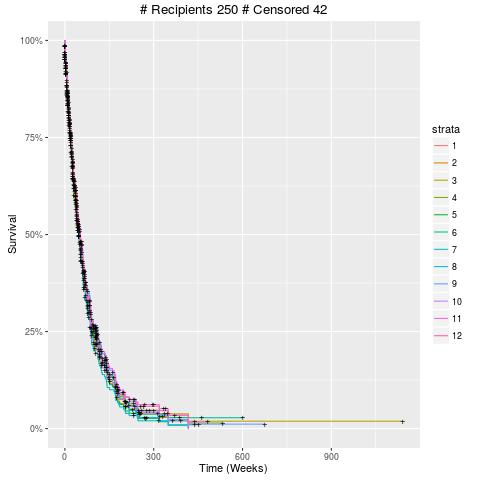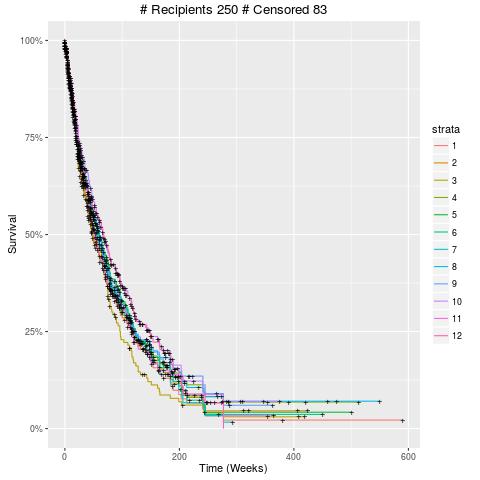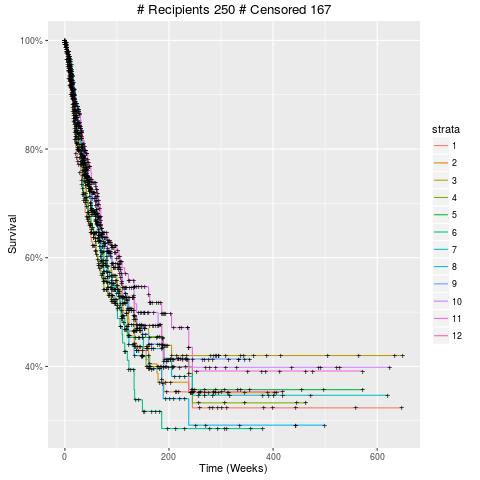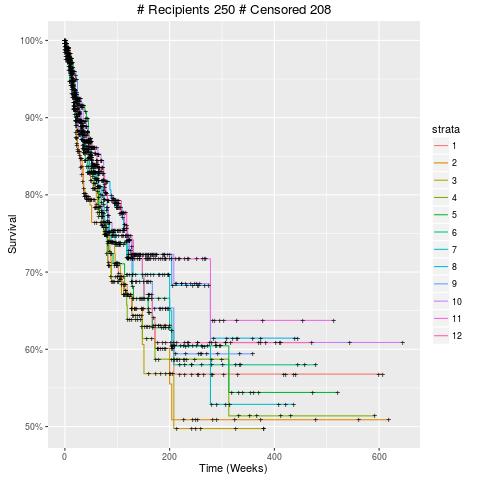This essay explains the principles of lifetime models with numerical assessment of lifetime models with censoring, competing risks and multi-state data. The applied statistical analysis is focusing on Cellular Therapy Observational Research Database.
Introduction
The words infusion and transplant have related meaning, i.e. infusion is the actual transplant process in which specific cells are infused into the recipient. After the infusion, the recipient is monitored for signs of any side effects from the treatment and to evaluate his medical status. The information related to this infusion process and to the subsequent follow up are recorded in a database with recipient & disease characteristics.Observational Research Database for research are formed. The database includes recipient baseline and outcome data for related and unrelated allogeneic transplants from any cell source, and for autologous transplants. The follow up information may report the following time depending events:
- survival status of the recipient.
- recipient died.
- additional cellular infusions performed for the same disease.
- response to the cellular therapy.
- development of second or new malignancies.
- development and severity of cytokine release syndrome and neurotoxicity.
- recipient simply is out or reach(not available for any contact).
CIBMTR
A number of databases related to cellular therapies(Center for International Blood and Marrow Transplant Research-CIBMTR, for instance) are maintained around the world to facilitate research into the outcomes of these therapies, i.e outcome of the performed therapy, including information on recipients and survivors followed since the start of the treatment(pre-infusion treatment). These databases may have key elements to answer essential questions related to cellular therapy outcomes. The outcomes are affected by recipient characteristics such as (age, gender, lifestyle) and disease factors such as (disease stage, prior therapies), as well as infusion dependent factors such as used cell source and infusion mode using autologous or allogeneic and son on.The statistical analysis of lifetime data in these databases is to play an important role in the development of optimal designs for clinical cellular therapies. The special statistical theory needed to analyze the Time-to-Event in these databases is called survival analysis with censoring( censoring has an important effect on data analysis and it's mainly the focus of this essay) and competing risks.
Illustrative Instance
Let's assume that our Time-to-Event study defines event as the date of first physical contact with the recipient after the cellular therapy infusion. The contact with recipient is important to evaluate medical status(post-cellular therapy examination).Two possible scenarios can be considered:
- The recipient physically contacted the physician. Time to event is not censored and a medical status is well defined.
- Absence of physical contact with the physician because the recipient died( may be related or not to the infusion), moved elsewhere(never to be seen again), or the recipient not interested to contact the physician because of unknown reasons.
This is a censored observation that contains only partial information about the variable of interest, date of first contact to evaluate medical status. - The event Death can be considered as censored or competing risk, i.e. a competing risk is an event whose occurrence precludes the occurrence of the primary event of interest, it will alter the probability of experiencing the event of interest. Note that treating the competing events as censored is inappropriate because in case the competing event has occurred the event of interest will not be observed.
Survival Curves
The Kaplan-Meier estimator (in non-informative censored observations) is a major step in the development of suitable models to analyze lifetime models with non-informative censoring. This non-parametric models is able to deal with any distribution without any additional assumptions.For unbiased analysis of Time-to-Event curves using the databases related to cellular therapies, it is essential that censoring effect on the calculation of Kaplan-Meier estimators should be highlighted by using at least synthetic databases that mimics the actual databases related to cellular therapies. This will help us to understand the impact of censoring in survival analysis and to prevent including grossly erroneous conclusions from the analysis of the actual cellular therapy databases.
A cellular therapy database, recording all the observations, is of great importance to answer essential questions related to clinical cellular therapy outcomes, i.e. assessing critical operational decisions and answering scientific research questions. In this essay we investigate a synthetic database based on a-priori knowledge about an actual database, i.e. review of records validity, proportion of censored recipients, nature of the statistical distribution and so on.
The generated data is to be valid and to be similar to real data in terms of statistical distribution. The synthetic database can be more illustrative for testing specific questions when the statistical distribution has mixture statistical distributions, for instance.
Mimic-A Cellular Therapy Research Registry Form
HOW DO I CREATE A PATIENT LIST?
We consider only type I right censoring. The recipients enter the study at different times; each recipient experiences a cellular therapy infusion. We are interested in observing their lifetimes to a specific event. Our database has the following form as an illustration:- Recipient Information: IUBMID, LN(LASTNAME), FN(FIRSTNAME).
- Covariates: for instance, Gender ( as random distribution in our database ).
- Times: FDD(FirstDiagosisDate), FTD(FirstTransplantDate), FRD(FirstRelapseDate), LCD(LossContactDate), DD(DeathDate).
- FirstDiagosisDate follows an uniform distribution. It is a distribution that has constant probability.
- FirstTransplantDate is equal to FirstDiagosisDate plus a period of time following an exponential distribution with a specific parameter of the distribution, often called the rate parameter.
- FirstRelapseDate is equal to FirstTransplantDate plus a period of time following an exponential distribution with a specific rate parameter.
- LossContactDate is equal to FirstTransplantDate plus a period of time following an exponential distribution with a specific rate parameter.
- DeathDate is equal to FirstTransplantDate plus a period of time following an exponential distribution with a specific rate parameter.
"NA" means the recipient has no data entry for that particular field.
| IUBMID | LN | FN | Gender | FDD | FTD | FRD | LCD | DD |
|---|---|---|---|---|---|---|---|---|
| 150 | LN000150 | FN000150 | Female | 1997/07/10 | 1997/08/19 | 1998/10/30 | NA | NA |
| 26 | LN00026 | FN00026 | Male | 1998/10/23 | 1998/11/23 | NA | 1998/12/10 | NA |
| 83 | LN00083 | FN00083 | Male | 2002/02/02 | 2002/05/07 | NA | NA | 2005/03/10 |
| 139 | LN000139 | FN000139 | Female | 1994/05/21 | 1994/07/19 | NA | NA | 1995/02/19 |
| 88 | LN00088 | FN00088 | Female | 2006/10/01 | 2006/10/26 | 2007/02/28 | NA | NA |
HOW DOES CENSORING MIXTURE DISTRUBITIONS AFFECT KM ESTIMATOR?
The global cohort of recipients is formed by 12 sampled sub-cohorts, A recipient, in the sub-cohort_i, may drop out during on average i months. Same number of recipients is assigned to any sub-cohort. The censoring distribution is obtained as a mixture of exponential distributions with means equal to 1 month, 2 months, ... , 11 months, 12 months.Each sub-cohort has 250 recipients. The number of censored recipients is the same in each sub-cohort and variable across the Figures.Each Figure has all the KM survival curves associated to the 12 sub-cohorts.





COMPETING RISKS
A competing risk is an event that either hinders the observation of the event of interest or modifies the chance that this event occurs. For example, when studying death on cell therapy, death event is an event that competes with the event of interest(First Relapse Date). Ignoring the competing event(s) in Kaplan–Meier method may be inappropriate for the accuracy of the survival curves. Methods have been designed for analyzing competing risks data. We first explain the problem of competing risks in survival analysis and how using suitable techniques may improve survival curves results when competing risks are well-defined(not censored events, better specified and described) which would make not including them in the censoring less leading to grossly erroneous conclusions. The results need to be added ...Comparing Survival Curves Between Two Prognostic Subgroups
Two essays are treating this section by considering the Precision Medicine Project. The Precision Medicine Project aims to extract a comprehensive scientific knowledge to be tailored to the individual patient using cohort studies with goal to foster understanding of health and disease.-
We are interested to assess the analytics and the numerics of the cohort formation and its relation of the accuracy and reliability of the project using
cohort studies, i.e. impact of censoring on the used formulations to estimate the sensitivity and specificity values and by consequent on the difference in survival:
- Essay I- Predictive Values function of Specificity/Sensitivity/Prevalence in the absence of Censoring.
- Essay II- Predictive Values function of Specificity/Sensitivity/Prevalence in the presence of Censoring.
Author scientific profile:
Statistics and Applied Mathematics for Data Analytics, Identify opportunities to apply Mathematical Statistics, Numerical Methods, Machine Learning and Pattern Recognition to investigate and implement solutions to the field of Data Content Analytics. Data prediction via computational methods to predict from massive amounts of data (Big Data Content). These methods included clustering, regression, survival analysis, neural network, classification , ranking, deep discrepancy learning .
Author: Faysal.El.Khettabi@gmail.com , Living in Vancouver, BC, Canada.
The MIT License (MIT) Copyright 1994-2017, Faysal El Khettabi, Numerics&Analytics, All Rights Reserved.
The MIT License (MIT) Copyright 1994-2017, Faysal El Khettabi, Numerics&Analytics, All Rights Reserved.